P A Thakare1, Dr. Neeraj Kumar2, Dr. Vinay Ugale3
1 Ph. D research scholar, Mechanical engineering Department, Suresh Gyan Vihar University, Jaipur, Rajasthan.
2 Professor in Mechanical Engineering Department, Suresh Gyan Vihar University, Jaipur, Rajasthan.
3 Asst. Professor, College Of Military Engineering, Pune, Maharashtra.
1 pat_thakare@rediffmail.com
2neeraj.kumar1@mygyanvihar.com
3vinayugale@gmail.com
Abstract – There is an enormous scope to develop suitable hybrid composites materials for various types of applications to replace the costly and heavier conventional materials. In this paper, a FRP composite made of flax and hemp as natural fibers and outside face sheet of kevlar as synthetic fibers is studied for flexural and impact properties. The flexural strength for developed panel was 238.3 MPa with flexural modulus of 4.02 MPa with high impact energy upto 24J with less damage area.
Keywords— Fiber reinforced polymer, flax, hemp, kevlar, impact strength, delamination area.
- INTRODUCTION
Fiber Reinforced Polymer (FRP) composites are generally used in various applications such as structural members, aerospace, architectural furnitures, sports items etc. because of their lower weight, high stiffness and strength, impact resistance behavior and maximum flexibility in manufacturing. FRP in regular practice are fabricated with synthetic based fibers such as glass and carbon, which are costly and non-ecofriendly. Utilization of natural fibers from plant, leaves and seeds is always an advantage. Different natural fibers such as sisal, banana, coir, flax, jute, hemp, cotton etc. are being used in making of an FRP composite for various types of uses. Rohit and Dixit [1] brought out the future trend of natural fiber reinforced composites through evaluation of various mechanical properties and biocompatibility with upcoming tests for indoor and outdoor uses. Natural fiber has moderated strength, light weight and eco-friendly nature. To increase mechanical strength and other properties of natural fibers, chemical treatment to reduce the hydrophilic nature is must before fabrication as suggested by various researchers [2], [3], [4], and [5]. Harish et al. [6] studied the coir/epoxy composite fabricated by hand lay-up method and characterized for several mechanical properties. Flexural strength of 31.08 MPa and impact strength of 11.49 KJ/m2 was attained displaying greater interfacial bond strength. Hybrid FRP panel made of synthetic and natural fibers are gaining attention in making different types of products. Pickering [7] in the review paper, provided the detailed properties such as flexural strength, impact behaviour and strength/stiffness of natural fibers used to make hybrid FRP composite. Alagarraja et al. [8] worked on glass-sisal FRP composite using hand lay-up method. Sanjay [9] studied the FRP composite made of Glass-jute. Tensile strength and flexural strength of 85 MPa and 114 MPa was attained with impact strength 7.12 J.Hoo Tien Kaun [10] demonstrated that volume fraction of fibers made of glass improves impact behaviour. [11] Studied plant fiber FRP composite made of jute, sisal, flax and hemp fibers, traditionally available in rural India. Through extensive research done by researchers, [7], [12], [13] flax and hemp fibers possess better mechanical properties such as tensile strength, young’s modulus, % elongation etc. as compared to other available natural fibers. Kevlar as a synthetic fiber provides better static and dynamic property as an outer skin of the composite [14].
In the present paper, a hybrid FRP composite combination is made from flax and hemp fibers as core portion and kevlar as outer face sheet to take the advantage of both. The FRP panels are experimentally characterized under flexural bend test and low velocity impact test to explore the possibility of replacing existing conventional FRPs made of only synthetic fibers.
- EXPERIMENTAL DETAILS
- Materials and fabrications
Flax (360 gsm) and hemp (335gsm) natural fiber with kevlar fiber (200gsm) are used to make the required FRP composite panel represented as FH-FRP was fabricated using vacuum bagging method.
The stack formation was kevlar/flax/hemp/hemp/flax/kevlar with the overall thickness of 4.2 mm as shown in the Fig. 1.
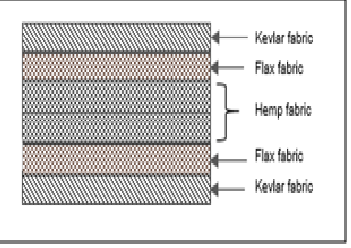
Fig.1 Stack formation of FH-FRP panel
A NaOH chemical treatment of 0.1% was done on both the natural fibers before fabrication. Epoxy mixture of resin and hardener were used to make the FRP composite in the ratio of 10:1 by weight. The vacuum pressure was created upto 0.52 bar by vacuum pump to get uniform volume fraction of around 0.38 through vacuum bagging method as shown in the Fig. 2.The mass per unit area of fabricated FH-FRP panel was 4479 gsm.
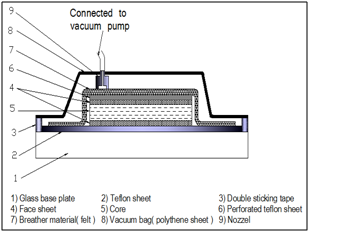
Fig. 2 Fabrication set up for FRP
1) Three-point flexural test: The rectangular specimens of size 110 mm × 20 mm of FH-FRP panels were tested for flexural test through three-point bend test (Fig. 3) on Universal Testing Machine (UTM)according to the ASTMD-790 standard. The above test was conducted to get the load Vs deflection, flexural strength and modulus of the FH-FRP panel.
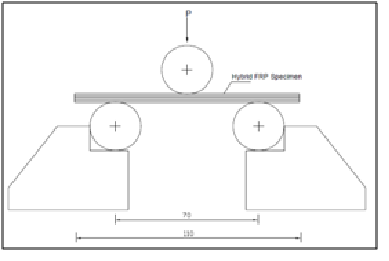
Fig. 3 Three point bend test set up
2) Low velocity drop weight impact load test: A low velocity drop weight impact load test was performed on FH-FRP panel specimen of size 160 mm × 160 mm. The test was to study the impact behavior at 6J, 12J, 18J and 24J respectively under ASTM A370 standards as shown in Fig. 4.
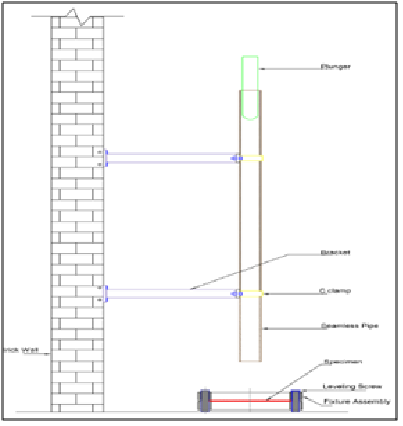
Fig. 4 Drop weight impact test set up
III. RESULTS AND DISCUSSION
- Flexural test.
Five specimens were tested on UTM to study the load Vs deflection, flexural strength and modulus for FH-FRP panel. The load Vs corresponding deflection curves for FH-FRP panels are shown in Fig. 5.
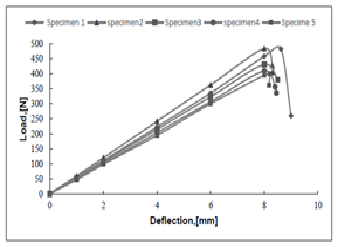
Fig. 5 Load Vs deflection in FH-FRP panel
The characteristics pattern for FH-FRP showed nearly linear elastic behavior till the critical load and sudden drop afterwards indicating the failure in FRP specimen tested. The peak load for FH-FRP was around 484 N with corresponding deflection of 8 mm.
The flexural strength was estimated numerically using the stress equivalent to the peak load afterwards estimated through ANSYS software. The average flexural strength for FH-FRP panel was 238.3 MPa which was quite higher than other natural fiber FRPs studied in the literature review. The flexural modulus D is calculated using equation, D = mL3/4bd3, where L is span length of specimen (mm) and m is the slope of the initial portion of load-deflection curve, b and d are the width and thickness of the specimen respectively [15] using the experimental values of peak load and the equivalent deflection. The flexural modulus for FH-FRP panels was 4.02 MPa.
- Low velocity impact load test
After observing the flexural behavior of FH-FRP which was at par with other types of FRP the low velocity impact load drop test was performed on FH-FRP panel specimen to study the impact behavior at 6J, 12J, 18J and 24J respectively using the drop weight impact test set-up.
1) Damage area: The damage area of four specimens was measured under the impact of 6J, 12J.18J and 24J respectively. Damage was primarily due to delamination; which was more on rare side and estimated using planimeter. The overall damage area for FH-FRP were 561 ± 8 mm2, 935 ± 17 mm2, 1528 ± 21.5 mm2 and 2255.5 ± 28.5 mm2 respectively at 6J, 12J, 18J and 24J respectively. The specimens were not penetrated under high impact energy of 24J, however the overall damage area due to delamination in these panels was observed at all impact energy levels as shown in the Table 1 and in the Fig. 6.
The impacted specimen was cut into eight sectors around the centre of impact and cross section was observed. The delamination was predominantly seen between flax and hemp fabric layers. This is mainly due to weaker cohesion between theses heterogeneous layers in the FH-FRP.
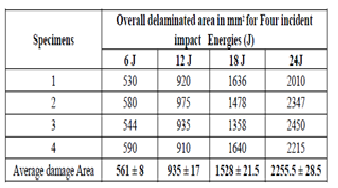
TABLE 1Overall delaminated area of FH-FRP panels
Fig. 6Experimental observation of damage area of FRPs under impact loading
2) Residual energy: The difference between the incident energy and rebounced energy gives us residual energy. The residual energy for FH-FRP panels was determined and found to be 1.42J, 6.64J, 8.8J and 15.4J at 6J, 12J, 18J and 24J respectively. Residual energy gives rise to delamination, breakage of fibers, matrix breakage etc.
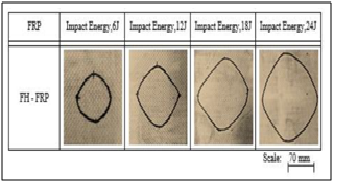
- CONCLUSIONS
A hybrid FRP composite with stack formation comprising of both flax and hemp along with kevlar was fabricated using vacuum bagging method with volume of fraction around 0.39. This configuration tested for flexural and impact test.
The flexural strength for FH-FRP panel was 238.3 MPa with flexural modulus of 4.02 MPa which was quite higher than other natural fiber FRPs studied in the literature review. The specimens were not penetrated under high impact energy of 24Jwith less damage area showing higher impact resistance for various range of application. Further studies can be taken for FH-FRP such as thermal stability test, vibration and acoustic analysis to explore in many more applications.
ACKNOWLEDGMENT
We acknowledge the staff of Deptt. of Mechanical Engg, Suresh Gyan Vihar University for the technical assistance and support.
REFERENCES
[1] Rohit K. and Dixit S., “A review- Future aspect of natural fiber reinforced composite”, Polymers and Renewable Resources, 7(2), 43-59. 2016.
[2] Chubuike O. M., Ebele C.C., Ifeanyi I., Okwuchukwu S. and Festus O.E., “Study on chemical treatments of jute fiber for application in natural fiber reinforced composites (NFRPC)”, International Journal of Advanced Engineering Research and Science, 4(2), 21-26, 2017.
[3] Mwaikambo L.Y.,Ansell M.P.,“Chemical modification of hemp, sisal & kapok fibers by alkalization”, Journal of Applied Polymer Science, 84, 2222-2234, 2002.
[4] Begum K. and Islam M.A., “Natural fiber as a substitute to synthetic fiber in polymer Composites”, Res. Journal of Engineering Sci., 2(3), 46-53, 2013.
[5] Hoo Tien Kuan and Wesley Cantwell, “The mechanical properties of hybrid Composites based on self- reinforced polypropylene”, Malaysian Polymer Journal, 4(2), 71-80, 2009.
[6] Harish S., Peter Michael D., Bensely A. and Rajadurai A., “Mechanical property evaluation of natural Fiber coir composite”, Materials Characterization, 60, 44 – 49, 2009.
[7] Pickering K. L., Efendy A., Le T. M., “A Review of Recent developments in natural fiber composites and their mechanical performance”, Composites: Part A, 83, 98-112, 2016
[8] Alagarraja K., Damodharan A., Gopinathan K., Mathan Raj R. and Ram Kumar, “Fabrication and testing of fiber reinforced polymer Composites material”, Journal of Mechanical and Civil Engineering (IOSR-JMCE), 27-34, 2014.
[9]Sanjay M., Arpita G.R. and Yogesha B., “Investigation on mechanical property evaluation of jute – glass fiber reinforced polyester”, Journal of Mechanical and Civil Engineering, 14, 50- 57, 2011.
[10] Hoo Tien Kuan and Wesley Cantwell, “The mechanical properties of hybrid Composites based on self- reinforced polypropylene”, Malaysian Polymer Journal, 4(2), 71-80, 2009.
[11] P A Thakare, Neeraj kumar and V B Ugale, “A review on recent developments of hybrid composite made of natural and synthetic fibers”, International conference on evolution in manufacturing technologies for global competitiveness, BIT, Mesra, Ranchi, Nov 2016.
[12] Kumar S.S. and Anbumalar V., “Selection and evaluation of natural fibers- A literature review”, International Journal of Innovative Science, Engineering and Technology, 2(11), 929-939, 2015.
[13] Mitra B.C., “Environment friendly composite materials: Biocomposites and green composites”, Defence Science Journal, 64(3), 244-261, 2014.
[14] P A Thakare, Neeraj kumar and V B Ugale, “The effect of hybridization on mechanical behaviour of kevlar and natural fiber reinforced composite”, IJMPERD- ISSN: 2249-6890, Vol 9, 507-516, 2019.
[15] Gupta M.K. and Srivastava R.K., “Mechanical, thermal and dynamic analysis of jute fiber reinforced epoxy composite”, Indian Journal of Fiber and Textile Research, 42, 64-71, 2017.
